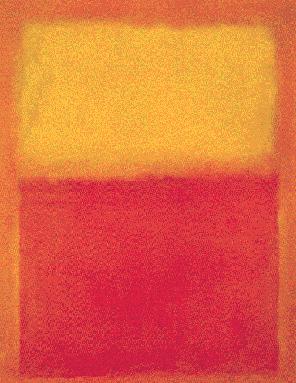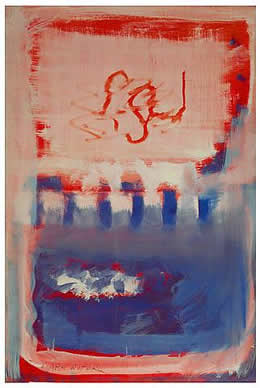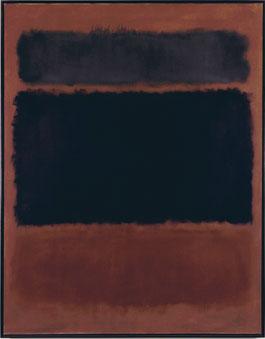The Clouded Glass
John Haberin New York City
Mark Rothko: A Retrospective
I did not go to the Rothko Chapel to pray. Even in a hushed room, I could not hope for a reflection of myself or of God. I could not safely turn from the dark canvas surrounding me to contemplate something else. Put away talk of pure plasticity and the sublime's cosmic drama. I had entered a place where I could live for a while with myself.
Mark Rothko created that special place, and I have entered it again. I do not mean the building I once visited in Houston. I mean the place one enters at his retrospective in Washington and, later, at the Whitney.  As I left, I thought back with a shock on what the age of big-time museums takes for granted. I had forgotten how art can darken the world's mirrors to let in a stronger light.
As I left, I thought back with a shock on what the age of big-time museums takes for granted. I had forgotten how art can darken the world's mirrors to let in a stronger light.
Critics have compared that light to the harsh northern sun. They have recalled the grand aspirations of the nineteenth-century sublime. Perhaps, but Rothko offers something more down to earth. A Romantic mirror of the eternal seems far away. These paintings hold out a darker, far more palpable kind of mirror, the clouded glass of everyday perception.
Resting on a twisted ground
People do not ignore Rothko's retrospective. They do not talk through it or walk through it half bored. They come, and they stay for a long time. For the first show in memory, people sit on the floor, back apart from the work, to give it space—in the room, in their heads. They include museum-goers so young that they really should demand something more obviously postmodern. They have found a place, for a little while at least, to live.
Mark Rothko took time to reach that desire for himself, almost to the eve of his suicide in 1970. Like his friend Adolph Gottlieb, he blossomed late, well after leaving Latvia and then Portland, Oregon. And he continued to develop into his mid-60s, but his influences stayed with him all his life.
Rothko's first works, already well into his twenties, mark his first act of turning away. On the surface, and surfaces will always matter to Rothko, they have no ties to the past. Some paintings aim for the reality of New York's urban scene and the American century, from passing trains to passing faces. Others take up the febrile line of Surrealist drawing and Surrealism in America. In these paintings, a city's emotional energy sits at odds with its solid outer space. Surrealism's fluid inner world meets an insistence on human form.
After a few rooms of this show, I could finally see the great rectangles floating above. The pallid realism, formalism, and Surrealism are gone for good. Still, I thought back to the small rectangle at the bottom of an early painting, a subway platform in a dusky city, well before the melodramatic Subway of George Tooker. The ground plane gives the painting its packed, shallow space, only it has come loose from perspective, twisting into a solid ground that only art can provide.
A ground is not a comfort either, just as the museum-goers sitting spread-eagled are not necessarily taking naps. Think of vertical bed linens from Robert Rauschenberg a decade later, only unbloodied, or saturated canvas by Joan Miró in his Birth of the World. Yet Rothko's urban intensity and unease create a new art.
Waiting to inhale
In the show's opening room, only a self-portrait pulls off much depth. It also looks ahead to the Bay Area school of the next generation. Drab attempts at Surrealism to either side accomplish only so much. Rothko's brushwork takes time to encompass details of color and immensity of form. The inner and outer life of painting take years to collide in a single work.
 Even Rothko's large abstract paintings have to find their way. In an early one he peels off the topmost oil layer to leave two thick, wavy lines. He wants to stretch one's line of sight past the limits of a rectangle, but the device seems forced. I like the painting, but I still see Surrealist doodling dancing on a subway platform. A foreground color has not yet taken shape from the neighboring colors that it absorbs and leaves behind.
Even Rothko's large abstract paintings have to find their way. In an early one he peels off the topmost oil layer to leave two thick, wavy lines. He wants to stretch one's line of sight past the limits of a rectangle, but the device seems forced. I like the painting, but I still see Surrealist doodling dancing on a subway platform. A foreground color has not yet taken shape from the neighboring colors that it absorbs and leaves behind.
Once it does, Rothko shares with Jackson Pollock and the best of Abstract Expressionism a perilous rigor. No funny stuff here, in either sense of the word funny. His temperament could not accommodate the biting irony or forgiving serenity of Willem de Kooning. It could not afford time to tell a story from right to left, like Robert Motherwell in his hints of a stony, inhuman procession. Harold Rosenberg promoted "action painting," but this painter knows when to lie still and breathe.
Above all, Rothko wants no tricks. Ad Reinhardt, with his sudden revelation of color in apparent black, seems trickery by comparison. Even drawing or texturing would suggest sleight of hand, so it must not exist apart from color. I thought of how Jasper Johns would later pull a canvas apart to prop up steel balls. If abstract art sounds in hindsight too macho, forever trying to prove it has balls, Rothko's masculinity catches in his throat.
With each year, colors get sharper, deeper, and subtler, and Rothko fusses less over each rectangle. The strokes blend as if to recreate themselves elsewhere, and they hardly worry about what looks deep or flat. The emotional tenor changes, too. At first color runs wild as it merges into larger and brighter fields. As it intensifies, however, it darkens, and a reverse process sets in. Now bright tones become less relevant, because grey itself speaks so much of color.
I felt a tightening in my breathing well before his death. It is as if those museum-goers looked so relaxed because they could finally exhale—or so intense because they found no air to breath. Rothko's early, derivative styles were all ways of waiting to inhale.
Clouding the labels
The retrospective has its old-fashioned side. Wall text does not comment on each painting, and one has a hard time locating the labels that remain. Works sit comfortably side by side in large rooms.
The show pretty much forgets about the man's life and times. It brings one no closer to understanding his death by his own hand—although in fact his health had suffered and he had separated from his wife. The curator, Jeffrey Weiss, ascribes even the darkening solely to the demands of commissions. He points to Rothko's work with Philip Johnson, the architect, first on the planned murals for the Four Seasons restaurant in New York, later for the chapel.
Like Rothko's inner world keeps confronting painting's objectivity. America and then New York City promised freedom. They left an immigrant with a cavalier command of inherited traditions, from realism to formalism and Surrealism. Yet they also left a proud man hoping to stand apart from it all, to explain himself in no terms but his art's. It is as if one could be oneself only by standing outside history.
The step outside of history had itself a history. New York absorbed Europeans and European traditions, while their heritage lay in ruins. It drew on its past as a great industrial center while making the first hesitant steps toward a post-industrial city. Wall Street continued to trade slips of paper in place of things, at least a little longer, while artists slowly took over factory spaces, and museums grew into cultural institutions.
Rothko helped art take that step outside of history. He developed the image in series, like metal tiles for Carl Andre or Marilyn for Andy Warhol, with reference outside itself cast to the emotional winds. His last works turn away again from familiar points of reference, by a progressive darkening.
Debating clarity
When one thinks of him as a formalist or sublime, one has it only part right: his art never gives up mirroring reality. It just demands that one live beside a clouded glass.
For a while now, painters and others suspicious of "theory" have wanted things clear—maybe even too clear. Abstraction's beauty had too many strings attached, they felt. Postmodern irony and cultural politics, in turn, often lack the critical distance to untie the strings. Besides, irony and politics reduce art to words. And yet surely something clear, something palpable, remains beyond words. Well, somewhere. Painting or its successors, something has to go.
The debaters spend too much time looking for the right words or for a way outside them, toward a religious aura for art. The only real way outside language is to use it precisely, to revel in its contradictions. Art reflects—and reflects on—its culture most persuasively when it gets tangled up in the strings. 
When Postmodernism quotes tradition and formalism, it makes the two pierce right through each other. Rothko's generation faced the terror of achieving both. His shallow space refuses depth or flatness. And no one else matched the depth of his refusal. Perhaps he just kept at it, whereas Jackson Pollock burned out well before Minimalism. Perhaps he began with a grimness that already threw a cloud over the American dream.
Up close and apart
Pollock stretches freely across the wall, backing away from each edge because its power never runs up against limits. Rothko's rectangles pull only so far before they pile up too much tension. Pollock's sky is America's immense west. Rothko remembers a far colder climate—his native Latvia or an American childhood in Oregon, a drab studio in New York's winters.
When Pollock or Janet Sobel leaves drips, one makes one's own space between them. Rothko's brush refuses to run free. It cannot abandon the texture of its many thin layers of saturated oil on pigment and binder. The canvas has to dominate a room, but only by growing to human scale. When one's eye enters his brightest yellow-orange, one finds one's way as if in the dark. Finally, one sits still and learns to live with it.
And that is Rothko's relevance to Postmodernism, even had his glow and layering not penetrated painters such as David Reed. Like Minimalism after him, he points in two directions—back to urban America in all its glory and ahead to a culture without a center. Vir Heroicus Sublimus, by Barnett Newman, posits "man the sublime hero." This retrospective looks well beyond the male hero. Its sublime is a mirror that one can hold in one's hand and watch as it grows dark.
One has that room with others to get up close and to sit apart. I may worry about the show's next stop, the Whitney, but imagine trying that with modern art at the Guggenheim sometime. If the curator's reticence leaves far too many mysteries to unravel, others will have to tell the story. Maybe the show will help them start.
A postscript: Rothko in New York
The Whitney's approach has more of the familiar. It begins with lines and crowds. Barriers keep one's nose out of the art, and decorum keeps one's seat off the floor. A huge room smack in the middle of the fourth floor gives Rothko a cathedral space. He might have left immediately for his private chapel.
The rooms stretch over two floors. They also stretch out one's experience of early work, and openings between rooms cause some curious distractions. Colors look more somber in the generally lower lighting. One forgets that these oils soak up every bit of light one offers them.
Yet the move to New York brings Rothko closer to home. Those early years seem more natural near the Whitney's collection of prewar American realism. The very word realism starts to sound more foolish than ever for titles like Underground Fantasy or Iphigenia. Rothko's unfinished murals have a kind of homecoming, too, barely a mile from their intended destination at the Four Seasons restaurant. They look less overblown in the process.
Above all, the lower lighting and open doorways make the New York show a great place to study color. Rothko's own studies on paper, a kind of postscript in the show's first stop at the National Gallery in Washington, receive a side room at the Whitney. I noticed for the first time the feathery touches, loose strokes, and poured paint late in his life. I noticed, too, the increasing reliance on mixed oil and acrylics then, and I could connect the new media and dark, casual surfaces to Minimalism. For better or worse, the Whitney makes Rothko a little less of a magician and a little more of a technician.

Mark Rothko ran at The Whitney Museum of American Art through November 27, 1998, and before that at the National Gallery of Art in Washington. A related review looks at Rothko in a critical year, 1949.




